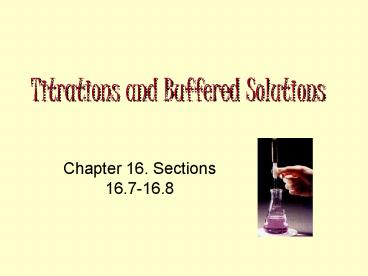Titrations and Buffered Solutions PowerPoint PPT Presentation
1 / 17
Title: Titrations and Buffered Solutions
1
Titrations and Buffered Solutions
- Chapter 16. Sections 16.7-16.8
2
POP QUIZ!
- Open Note!
3
Pop Quiz Open Note
- What would be the OH- if the H is 2.6 x
10-8? - What is the pH of a solution that has a
concentration of OH- 2.0 x 10 -2 M - Calculate the pH value for a solution in which
H 1.0 x 10-3 - The pOH is found to be 6.59, what is the H and
OH-? - Calculate the pH of a solution of 5.0 x 10-3 M
HCl?
4
Review
- What does pH measure?
- What makes something an acid? A base?
- What is the relationship between the strength of
an acid or a base and its conjugate?
5
Acid-Base Titrations
- As you know that a strong acid contains H ions
in solution and a strong base contains OH- ions
in a solution - So the net ionic reaction in a strong acid base
reactions is - H(aq) OH-(aq) ? H2O(l)
- This reaction is called a neutralization reaction
6
Acid-Base Titrations cont
- To analyze the acid or base content of an unknown
solution, scientists often use a titration - A titration is a technique in which a known
solution is used to analyze the unknown solution - A measured volume of a solution of a known
concentration called a titrant is used to
neutralize an unknown solution called an analyte
7
Acid-Base Titrations cont
- If the analyte is an acid or base, titrant would
be a standard solution, or a solution of known
concentration - The standard solution is loaded into a buret
- A buret is a long cylinder with a stopcock at the
bottom and is graduated to tell you exactly how
much liquid is in it
8
Acid-Base Titrations cont
- From the buret, the titrant is added slowly to
the unknown liquid, until enough on the titrant
has neutralized all of the analyte. - All of the H and OH- have reacted to form H2O
- This is called the stoichiometric point or the
equivalence point for the titration - You can tell when all has been neutralized by an
indicator
9
Acid-Base Titrations cont
- Example
- Lets say I have unknown concentration of HCl, but
I have known concentration of NaOH. - When the amount of H from the HCl has completely
reacted with all of the OH- from the NaOH, then I
will have a pH of 7.
10
Acid-Base Titrations cont
- Determine The concentration of .25 liters HNO3
that .050 L of .200 M NaOH neutralizes - 1) what is the reaction?
- H OH- ? H2O
- 2) How much OH- do I have?
- .050 L x .200 M .010 mol OH-
- 3) How much H would I need to react
- with the OH-?
- .010 mol H
- 4) So what molarity?
- .010 moles/ ,25 liters .4 M
11
Acid-Base Titrations cont
- You try one!
- Determine the volume of .250 M KOH required to
titrated .025 L of .150 M HCl - 1. Determine the reaction
- H OH- ? H2O
- 2. Find the moles of your known
- .025 L x .150 mole .00375 mole of H
- 3. Determine the moles needed of the unknown
- .00375 mol of OH-
- 4. Determine the volume needed
- M mol/ L or .250 M .00375 mol/ x
- x .015 L or 15 mL of KOH
12
Acid-Base Titrations cont
- If you monitor the pH of the solution during the
entire titration process and plot the pH, you
will get a graph of the pH versus the volume of
the titrant added. - This is called a titration curve or pH curve.
13
Buffered Solutions
- A buffered solution is a solution that resists a
change in its pH even when a strong acid or base
is added to it. - Example When a small amount of HCl is added to
pure water it can greatly change the pH, but when
it is added to a buffered solution, it changes
the pH only slightly.
14
Buffered Solutions cont
- Buffer solutions consist of a weak acid and its
conjugate base. - The resistive action is the result of the
equilibrium between the weak acid (HA) and its
conjugate base (A-) - HA(aq) H2O(l) ? H3O(aq) A-(aq)
15
Buffered Solutions cont
- Buffered solutions are very important in our
every day lives.
16
Buffered Solutions cont
- Characteristics of a buffered solution
- The solution contains a weak acid and its
conjugate base - The buffer resists changes in pH by reacting with
any H or OH- so that the ions do not accumulate
and drastically change the pH - Any acid reacts with the conjugate base
- Any base reacts with the weak acid
17
Homework
- Read pages 524-529, problems 1-5 on page 529,
problems 43 and 49 on page 535

